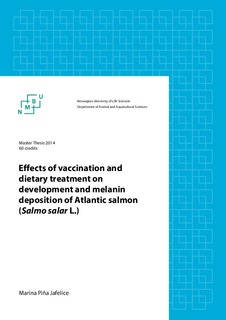| dc.description.abstract | Visual appearance is an essential quality property of food products. For salmonids the red color of the flesh is a main characteristic noticed by consumers, and fillets with discolored patches are downgraded. During recent years, dark melanin pigmentation has achieved great attention. In particular dark fillet spots are a costly problem for the salmon industry as such fillets cannot be sold as high quality products. The main goal of the present study was to investigate the effect of vaccination and dietary supplementation of zinc or vitamin E on appearance of Atlantic salmon (Salmo salar L.), starting before vaccination in freshwater (March 2013) until the fish reached 1.9kg in seawater (March 2014). The focus was on melanin deposition in abdominal organs, abdominal wall and fillets. Also overall fillet and liver coloration, occurrence of gaping and body conformation were evaluated additionally. Organ adhesions and the relative weight development of viscera, muscle, liver and heart were monitored throughout the experiment. The results showed that changes in melanin deposition differed between the tissues studied, with increasing incidence in fillets showing the clearest development. Melanin deposits were consistently higher in organs (significant) and abdominal peritoneum (numerically) of vaccinated compared with unvaccinated salmon. At the final sampling, the melanin score in fillets was significantly higher in the vaccinated (23% of the fillets) than unvaccinated salmon (10% of the fillets). Vaccinated fish also had higher scores for organ adhesions, smaller hearts during the early seawater phase (Sept-Dec), paler livers and higher liver% (HIS) immediately after vaccination, and larger livers at the final sampling, paler fillets but less gaping immediately after sea transfer. Compared with the control feed, dietary Zn supplementation resulted in higher fillet yield in December but lower yield in March, higher melanin score in organs and less adhesions in the early seawater phase, less visceral fat in December but higher in March, darker liver color, except immediately after vaccination. | nb_NO |

